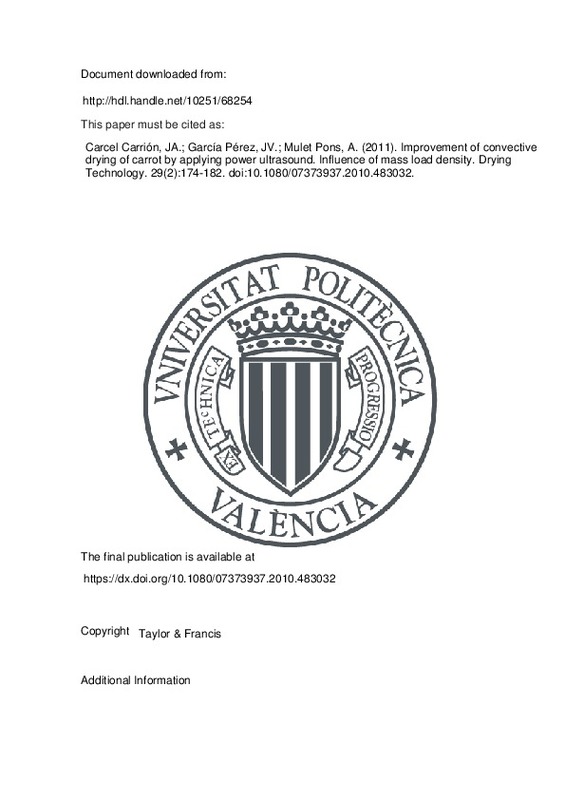JavaScript is disabled for your browser. Some features of this site may not work without it.
Buscar en RiuNet
Listar
Mi cuenta
Estadísticas
Ayuda RiuNet
Admin. UPV
Improvement of convective drying of carrot by applying power ultrasound. Influence of mass load density
Mostrar el registro sencillo del ítem
Ficheros en el ítem
| dc.contributor.author | Cárcel Carrión, Juan Andrés
|
es_ES |
| dc.contributor.author | García Pérez, José Vicente
|
es_ES |
| dc.contributor.author | Riera, Enrique
|
es_ES |
| dc.contributor.author | Mulet Pons, Antonio
|
|
| dc.date.accessioned | 2016-07-27T06:57:34Z | |
| dc.date.available | 2016-07-27T06:57:34Z | |
| dc.date.issued | 2011 | |
| dc.identifier.issn | 0737-3937 | |
| dc.identifier.uri | http://hdl.handle.net/10251/68254 | |
| dc.description.abstract | [EN] Power ultrasound is considered to be a novel and promising technology with which to improve heat and mass transfer phenomena in drying processes. The aim of this work was to contribute to the knowledge of ultrasound application to air drying by addressing the influence of mass load density on the ultrasonically assisted air drying of carrot. Drying kinetics of carrot cubes were carried out (in triplicate) with or without power ultrasound application (75 W, 21.7 kHz) at 40 C, 1 m/s, and several mass load densities: 12, 24, 36, 42, 48, 60, 72, 84, 96, 108, and 120 kg/m3 . The experimental results showed a significant (p < 0.05) influence of both factors, mass load density and power ultrasound application, on drying kinetics. As expected, the increase of mass load density did not affect the effective moisture diffusivity (De, m2 /s) but produced a reduction of the mass transfer coefficient (k, kg water/m2 /s). This was explained by considering perturbations in the air flow through the drying chamber thus creating preferential pathways and, as a consequence, increasing external mass transfer resistance. On the other hand, it was found that the power ultrasound application increased the mass transfer coefficient and the effective moisture diffusivity regardless of the mass load density used. However, the influence of power ultrasound was not significant at the highest mass load densities tested (108 and 120 kg/m3 ), which may be explained from the high ratio (acoustic energy/sample mass) found under those experimental conditions. Therefore, the application of ultrasound was considered as a useful technology with which to improve the convective drying, although its effects may be reduced at high mass load densities. | es_ES |
| dc.description.sponsorship | The authors acknowledge the financial support of the Spanish Ministry of Science and Technology (DPI2009-14549-C04-04) and the Universidad Politecnica de Valencia (PAID-06-08-3180). | en_EN |
| dc.language | Inglés | es_ES |
| dc.publisher | Taylor & Francis | es_ES |
| dc.relation.ispartof | Drying Technology | es_ES |
| dc.rights | Reserva de todos los derechos | es_ES |
| dc.subject | Dehydration | es_ES |
| dc.subject | Effective diffusivity | es_ES |
| dc.subject | High-intensity ultrasound | es_ES |
| dc.subject | Modeling | es_ES |
| dc.subject.classification | TECNOLOGIA DE ALIMENTOS | es_ES |
| dc.title | Improvement of convective drying of carrot by applying power ultrasound. Influence of mass load density | es_ES |
| dc.type | Artículo | es_ES |
| dc.identifier.doi | 10.1080/07373937.2010.483032 | |
| dc.relation.projectID | info:eu-repo/grantAgreement/MICINN//DPI2009-14549-C04-04/ES/Estudio De Los Efectos De Los Ultrasonidos De Potencia En Procesos De Transferencia De Materia. Mejora De La Liofilizacion A Presion Atmosferica/ / | es_ES |
| dc.relation.projectID | info:eu-repo/grantAgreement/UPV//PAID-06-08-3180/ | es_ES |
| dc.rights.accessRights | Abierto | es_ES |
| dc.contributor.affiliation | Universitat Politècnica de València. Escuela Técnica Superior de Ingeniería Agronómica y del Medio Natural - Escola Tècnica Superior d'Enginyeria Agronòmica i del Medi Natural | es_ES |
| dc.description.bibliographicCitation | Cárcel Carrión, JA.; García Pérez, JV.; Riera, E.; Mulet Pons, A. (2011). Improvement of convective drying of carrot by applying power ultrasound. Influence of mass load density. Drying Technology. 29(2):174-182. https://doi.org/10.1080/07373937.2010.483032 | es_ES |
| dc.description.accrualMethod | S | es_ES |
| dc.relation.publisherversion | https://dx.doi.org/10.1080/07373937.2010.483032 | es_ES |
| dc.description.upvformatpinicio | 174 | es_ES |
| dc.description.upvformatpfin | 182 | es_ES |
| dc.type.version | info:eu-repo/semantics/publishedVersion | es_ES |
| dc.description.volume | 29 | es_ES |
| dc.description.issue | 2 | es_ES |
| dc.relation.senia | 214054 | es_ES |
| dc.contributor.funder | Ministerio de Ciencia e Innovación | es_ES |
| dc.contributor.funder | Universitat Politècnica de València | es_ES |







![[Cerrado]](/themes/UPV/images/candado.png)

